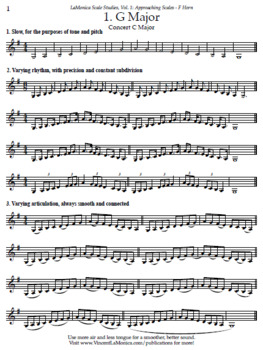

Place the mouthpiece on /3 upper lip and /3 loer lip. The mouthpiece should be centered from left to right, although it is fairly common for the position to be slightly off center because of the unique structure of each individual s ja and teeth. FORMING AN EMBOUCHURE The ord embouchure defines the formation of the lips and their placement on the mouthpiece. Remember, unless the right hand is positioned correctly, the location of tuning slides is irrelevant. Take care to avoid pointing the bell directly into the body, as this ill muffle the sound. This hand position ill remain the same hile lifting the bell off the lap as many advanced players do, or hen standing. The entire back of the fingers should be in contact ith the bell. Place the hand into the bell of the horn so that the triangle formed by the thumb and knuckle is supporting the eight of the instrument. Place the tip of the right thumb onto the middle knuckle of the index finger this ill force the hand to cup into the correct shape. To properly form the hand, extend the right hand as if shaking hands, ith fingers straight and not spread apart. When seated, players should rest the bell of the horn on the right leg. PLACING THE HAND IN THE BELL A proper hand position is critical for correct tone production and intonation. The finest players practice diligently and patiently, paying close attention to basics. One must train the ear as ell as the embouchure by internalizing pitches. Like a singer, one must hear the note before it can be played correctly. Example Horn Transposition & G on the horn sounds like C on the piano & b & & Concert Bb is played as an F on the horn The French horn is a difficult instrument to play and demands a great amount of concentration and attention to detail. The horn in F sounds a Perfect 5th loer than concert pitch. White GENERAL CONCEPTS The horn is a transposing instrument. Army Field Band French Horn Fundamentals French Horn Fundamentals by Sergeant First Class Patrick M. White The United States Army Field Band 44 Field Band Drive Fort Meade, Maryland Phone: (3) Fax: (3) /fieldbandģ The U.S. G chromatic scale No.1 The United States Army Field Band The Musical Ambassadors of the Army Washington, DC French Horn Fundamentals by Sergeant First Class Patrick M. The final 13th note is the octave note, having the same name as the starting note. In this case, the first explanation above applies - we will continue to use sharp notes ascending and descending to match the scale. An example G chromatic scaleįor this example - the chromatic scale in the key of G, let's assume that we are working with a key that is on the circle of 5ths - G major scale, which is a sharp-based key signature, and we want to identify some chromatic scale notes outside that key. when playing the notes from lowest to the highest pitch, then use flats when descending.
FRENCH HORN 12 MELODIC MINOR SCALES HOW TO
Chromatic scales without a key signatureįor both C major key signature and A natural minor key signature, there are no sharp or flat notes, so since there is no key signature, we have no clue as to whether to use sharp or flat names to identify any non-natural notes.Īlthough there seem to be no generally agreed rules on how to handle this, one common music theory convention is to use sharps when ascending the scale ie. Eb major key signature, where flat note names would be used.

The same principle applies to flat-based key signatures, eg. G major key signature, and we want to use the chromatic scale to identify notes outside that scale, sharps would be used for those chromatic scale notes. major scale, or any minor scale), then the key signature will be the guide as to whether to use sharps or flats for the chromatic scale.įor example, if a sharp-based key signature is used, eg. If chromatic scale notes are being used and identified within the context of a scale with a key signature (eg. Chromatic scale naming in the context of a key signature When it comes to naming the notes shown in the last step, the decision to be made is whether to use sharp or flat note names, both ascending or descending. This step gives note names to the piano keys identified in the previous step.


 0 kommentar(er)
0 kommentar(er)
